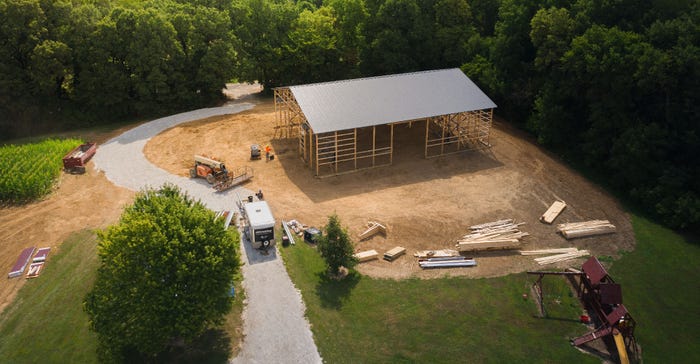
If you’ve recently seen a crew constructing what looked like a giant roof for a new building near ground level, you likely weren’t seeing things. It may have been an FBi Buildings crew assembling and preparing to raise a new building, all on-site. FBi Buildings, Remington, Ind., recently unveiled QLYFT, a unique way of constructing post-frame buildings.
“The idea originated in 2018, and we’ve been tweaking it ever since,” says Kurt Bahler, vice president of marketing for FBi. “Each of our crews now has access to the technology.”
The system uses hydraulic cylinders, I-beams, scissors-lift technology and safety nets to allow the crew to assemble the complete roof on the ground, build and attach the wall frames with hinges, and then raise the whole structure into place hydraulically. Usually, the entire process of raising the structure takes no more than 15 minutes, Bahler says.
Three factors drove FBi to develop this unique process. “The Q stands for quality,” Bahler says. “You get a better-quality building using this process, and it has a longer life span. Just as important, it’s much safer for our employees to build a building this way.”
Even the gutters are attached before the roof is raised. “The owner can run water in the gutters with a hose and check for leaks if he wants before we raise it up,” Bahler says.
How it works
Each QLYFT system can raise a 50-foot-long section up to 100 feet wide. Because extensions can be added, the system can be used no matter the length of the building. Four hydraulic cylinders per section apply the lifting power at 50 tons per cylinder, with the capability to raise up to a height of 24-foot eaves.
The building is surrounded with safety nets, so crew members don’t need safety harnesses while assembling the roof. Once the roof is finished, at ground level, and wall frames are attached by hinges just under the eaves, the barn raising begins. Typically, there is a hydraulic cylinder in each corner of the structure. Scissor lifts working with I-beams raise the roof.
Lasers allow a computer to monitor if the roof is being raised evenly. If somethings gets too far out of line, the system automatically stops so it can be corrected. If the power goes out unexpectedly, the cylinders lock in place.
Once the roof is raised to the proper height, the walls swing into place. Crew members then secure them to the building.
Bahler says the company worked hard to design the system so there would be only a minimal cost increase for the structure. “Since ceilings, insulation and wiring can be done while the roof is still on the ground, subcontractors may offer lower bids for their services,” he adds.
To learn more or see the system in action through video, visit fbibuildings.com/qlyft.
About the Author(s)
You May Also Like






